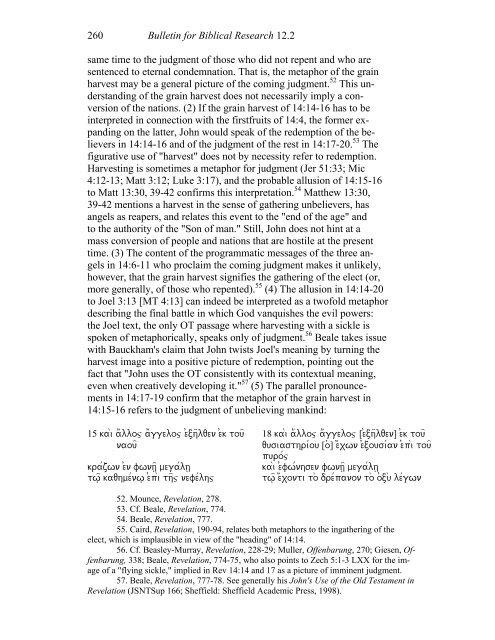John and the Future of the Nations - Institute for Biblical Research
John and the Future of the Nations - Institute for Biblical Research
John and the Future of the Nations - Institute for Biblical Research
Create successful ePaper yourself
Turn your PDF publications into a flip-book with our unique Google optimized e-Paper software.
260 Bulletin <strong>for</strong> <strong>Biblical</strong> <strong>Research</strong> 12.2<br />
same time to <strong>the</strong> judgment <strong>of</strong> those who did not repent <strong>and</strong> who are<br />
sentenced to eternal condemnation. That is, <strong>the</strong> metaphor <strong>of</strong> <strong>the</strong> grain<br />
harvest may be a general picture <strong>of</strong> <strong>the</strong> coming judgment. 52 This underst<strong>and</strong>ing<br />
<strong>of</strong> <strong>the</strong> grain harvest does not necessarily imply a conversion<br />
<strong>of</strong> <strong>the</strong> nations. (2) If <strong>the</strong> grain harvest <strong>of</strong> 14:14-16 has to be<br />
interpreted in connection with <strong>the</strong> firstfruits <strong>of</strong> 14:4, <strong>the</strong> <strong>for</strong>mer exp<strong>and</strong>ing<br />
on <strong>the</strong> latter, <strong>John</strong> would speak <strong>of</strong> <strong>the</strong> redemption <strong>of</strong> <strong>the</strong> believers<br />
in 14:14-16 <strong>and</strong> <strong>of</strong> <strong>the</strong> judgment <strong>of</strong> <strong>the</strong> rest in 14:17-20. 53 The<br />
figurative use <strong>of</strong> "harvest" does not by necessity refer to redemption.<br />
Harvesting is sometimes a metaphor <strong>for</strong> judgment (Jer 51:33; Mic<br />
4:12-13; Matt 3:12; Luke 3:17), <strong>and</strong> <strong>the</strong> probable allusion <strong>of</strong> 14:15-16<br />
to Matt 13:30, 39-42 confirms this interpretation. 54 Mat<strong>the</strong>w 13:30,<br />
39-42 mentions a harvest in <strong>the</strong> sense <strong>of</strong> ga<strong>the</strong>ring unbelievers, has<br />
angels as reapers, <strong>and</strong> relates this event to <strong>the</strong> "end <strong>of</strong> <strong>the</strong> age" <strong>and</strong><br />
to <strong>the</strong> authority <strong>of</strong> <strong>the</strong> "Son <strong>of</strong> man." Still, <strong>John</strong> does not hint at a<br />
mass conversion <strong>of</strong> people <strong>and</strong> nations that are hostile at <strong>the</strong> present<br />
time. (3) The content <strong>of</strong> <strong>the</strong> programmatic messages <strong>of</strong> <strong>the</strong> three angels<br />
in 14:6-11 who proclaim <strong>the</strong> coming judgment makes it unlikely,<br />
however, that <strong>the</strong> grain harvest signifies <strong>the</strong> ga<strong>the</strong>ring <strong>of</strong> <strong>the</strong> elect (or,<br />
more generally, <strong>of</strong> those who repented). 55 (4) The allusion in 14:14-20<br />
to Joel 3:13 [MT 4:13] can indeed be interpreted as a tw<strong>of</strong>old metaphor<br />
describing <strong>the</strong> final battle in which God vanquishes <strong>the</strong> evil powers:<br />
<strong>the</strong> Joel text, <strong>the</strong> only OT passage where harvesting with a sickle is<br />
spoken <strong>of</strong> metaphorically, speaks only <strong>of</strong> judgment. 56 Beale takes issue<br />
with Bauckham's claim that <strong>John</strong> twists Joel's meaning by turning <strong>the</strong><br />
harvest image into a positive picture <strong>of</strong> redemption, pointing out <strong>the</strong><br />
fact that "<strong>John</strong> uses <strong>the</strong> OT consistently with its contextual meaning,<br />
even when creatively developing it." 57 (5) The parallel pronouncements<br />
in 14:17-19 confirm that <strong>the</strong> metaphor <strong>of</strong> <strong>the</strong> grain harvest in<br />
14:15-16 refers to <strong>the</strong> judgment <strong>of</strong> unbelieving mankind:<br />
15 kai_ a!lloj a!ggeloj e)ch=lqen e)k tou= 18 kai_ a!lloj a!ggeloj [e)ch=lqen] e)k tou=<br />
naou=<br />
qusiasthri/ou [o(] e!xwn e)cousi/an e)pi_ tou=<br />
puro/j<br />
kra/zwn e)n fwnh|= mega/lh| kai_ e)fw/nhsen fwnh|= mega/lh|<br />
tw=| kaqhme/nw| e)pi_ th=j nefe/lhj tw=| e!xonti to_ dre/panon to_ o)cu_ le/gwn<br />
52. Mounce, Revelation, 278.<br />
53. Cf. Beale, Revelation, 774.<br />
54. Beale, Revelation, 777.<br />
55. Caird, Revelation, 190-94, relates both metaphors to <strong>the</strong> inga<strong>the</strong>ring <strong>of</strong> <strong>the</strong><br />
elect, which is implausible in view <strong>of</strong> <strong>the</strong> "heading" <strong>of</strong> 14:14.<br />
56. Cf. Beasley-Murray, Revelation, 228-29; Muller, Offenbarung, 270; Giesen, Offenbarung,<br />
338; Beale, Revelation, 774-75, who also points to Zech 5:1-3 LXX <strong>for</strong> <strong>the</strong> image<br />
<strong>of</strong> a "flying sickle," implied in Rev 14:14 <strong>and</strong> 17 as a picture <strong>of</strong> imminent judgment.<br />
57. Beale, Revelation, 777-78. See generally his <strong>John</strong>'s Use <strong>of</strong> <strong>the</strong> Old Testament in<br />
Revelation (JSNTSup 166; Sheffield: Sheffield Academic Press, 1998).
















